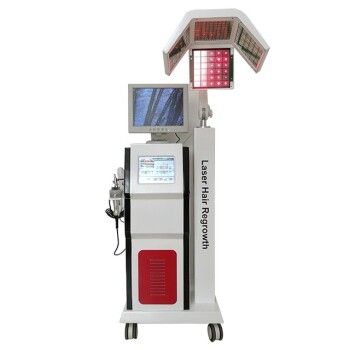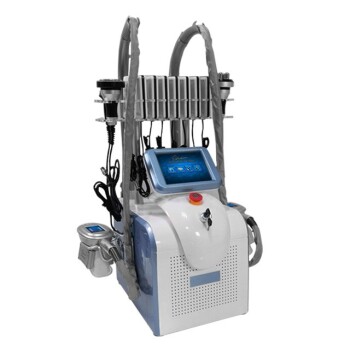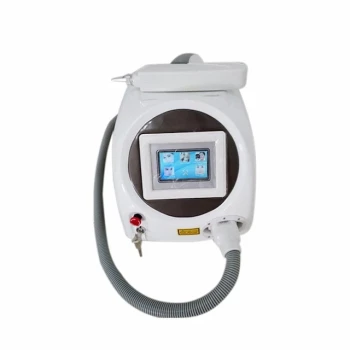Yes, laser lipo works, but its function is often misunderstood. It is effective for temporary and modest inch loss by causing fat cells to shrink, not by permanently removing them. For the results to last, you must maintain a stable weight and healthy lifestyle, as the fat cells can and will expand again if you gain weight.
The critical distinction to understand is that laser lipo is a non-invasive body contouring tool, not a permanent fat destruction method. Its success is measured in temporary inch loss for specific, stubborn areas, and its longevity is entirely dependent on your ongoing lifestyle choices.
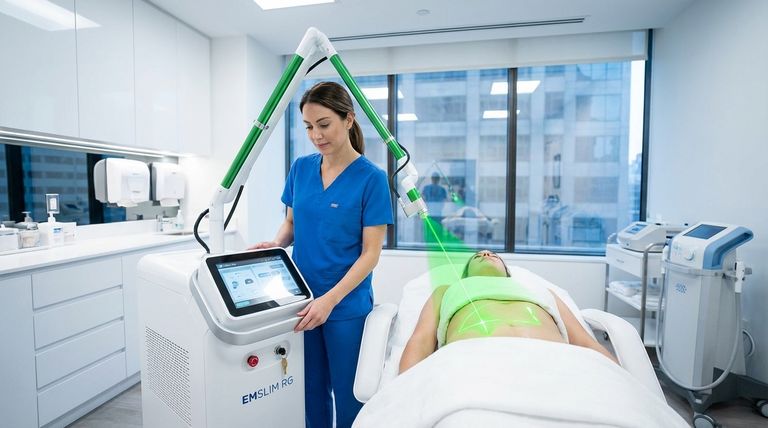
How Laser Lipo Works: The Cellular Mechanism
To judge its effectiveness, you must first understand the process. Laser lipo is a non-surgical procedure that uses low-level laser energy to target fat deposits.
The Role of Low-Level Lasers
Unlike surgical lasers, the energy used in laser lipo does not burn, cut, or vaporize tissue. Instead, it emits a specific wavelength of light that penetrates the skin to reach the subcutaneous fat layer.
Creating Temporary Pores
This laser energy stimulates the membrane of the fat cell, creating temporary pores or channels. This process, known as photobiomodulation, weakens the cell wall without destroying the cell itself.
Releasing Cellular Contents
Through these newly formed pores, the contents of the fat cell—primarily triglycerides (fatty acids and glycerol)—are released into the space between the cells. The fat cell itself collapses and shrinks in size.
The Body's Metabolic Response
This is the most critical phase. The released fatty acids are transported through your lymphatic system to be processed by the liver. They are then converted into energy, which your body must burn off through metabolic activity, such as exercise. If not used, the body can simply re-store them in other fat cells.
Understanding the Trade-offs: Shrinking vs. Removal
The effectiveness of laser lipo is best understood when compared to its surgical alternative, traditional liposuction. The two achieve results in fundamentally different ways.
The Question of Permanence
Laser lipo shrinks fat cells. The cells remain in your body, capable of re-expanding if you experience a caloric surplus. This is why results can be temporary.
Traditional liposuction removes fat cells. The cells are physically and permanently suctioned out of the treated area. The body does not typically generate new fat cells in adulthood.
Invasiveness and Recovery
Laser lipo is completely non-invasive, requiring no anesthesia and involving zero downtime. You can resume normal activities immediately.
Traditional liposuction is a surgical procedure that requires incisions, anesthesia, and a significant recovery period.
The Risk of Regaining Fat
With laser lipo, weight gain will likely cause the shrunken fat cells in the treated area to refill and expand, diminishing the results.
With traditional liposuction, if you gain a significant amount of weight, your body will store the excess fat in the remaining cells. This can sometimes lead to fat appearing in new or unusual areas.
Making the Right Choice for Your Goal
The "best" option depends entirely on your specific objective, time frame, and commitment to maintaining the results.
- If your primary focus is non-invasive, short-term body contouring: Laser lipo is a suitable option for modest inch loss in a targeted area, often used to look better in a specific outfit or for an event.
- If your primary focus is permanent removal of stubborn fat pockets: You should investigate cell-destroying technologies, with traditional liposuction being the surgical standard.
- If your primary focus is significant and lasting weight loss: Neither procedure is a substitute for a foundational plan of proper nutrition and consistent exercise.
Understanding the difference between shrinking a cell and removing it is the key to aligning the technology with your personal health and aesthetic goals.
Summary Table:
| Aspect | Laser Lipo | Traditional Liposuction |
|---|---|---|
| Mechanism | Shrinks fat cells | Removes fat cells permanently |
| Permanence | Temporary; cells can refill | Permanent |
| Invasiveness | Non-invasive; no downtime | Surgical; requires recovery |
| Best For | Modest, short-term contouring | Permanent removal of stubborn fat |
Ready to offer effective body contouring treatments to your clients?
BELIS specializes in professional medical aesthetic equipment, providing reliable laser lipo machines for medical aesthetics clinics and premium beauty salons. Enhance your service menu with safe, non-invasive technology that delivers visible results.
Contact our experts today to find the perfect equipment for your business needs and elevate your client outcomes.
Visual Guide
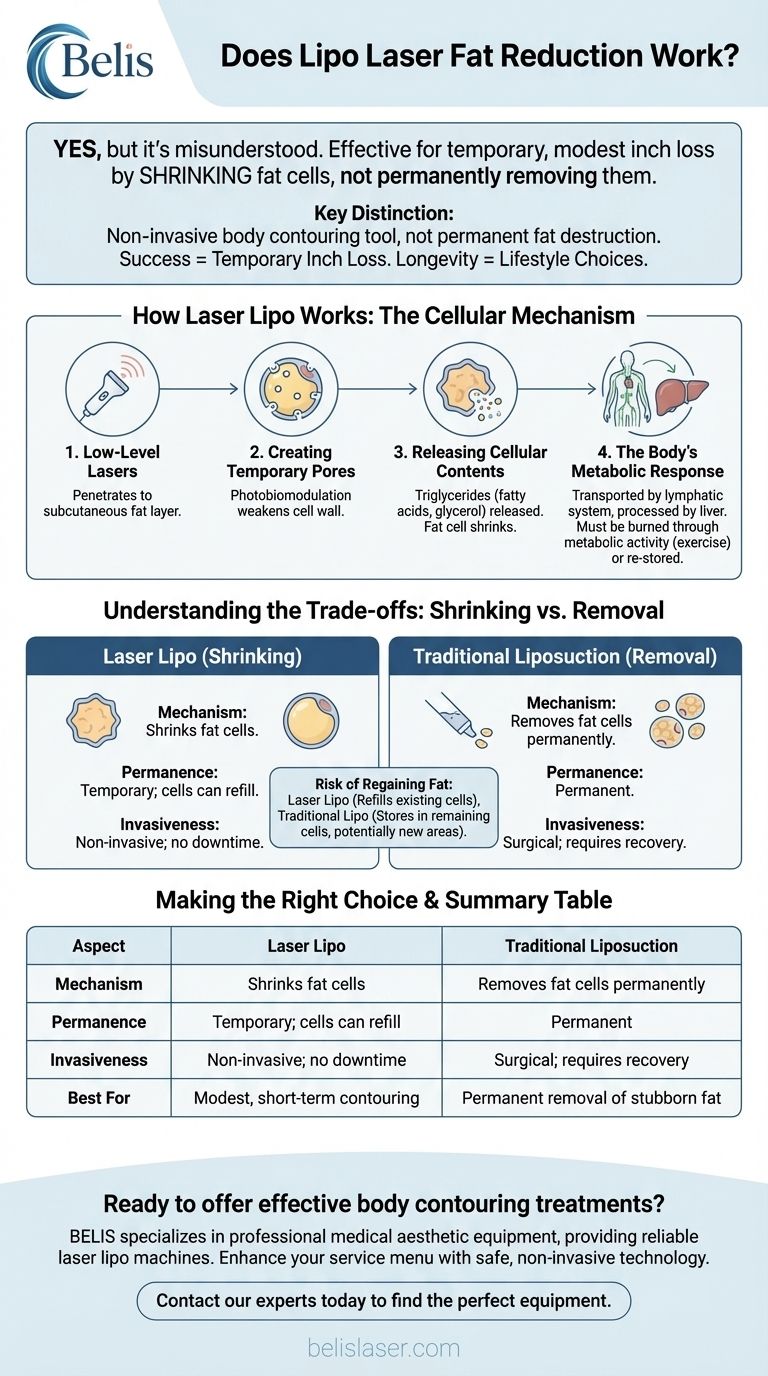
Related Products
- EMSlim RG Laser Body Sculpting and Slimming Machine
- Cryolipolysis Fat Freezing Cavitation Lipo Laser Machine
- Cryolipolysis Fat Freezing Machine Cavitation Lipo Laser Machine
- 12D HIFU Machine Device for Facial HIFU Treatment
- Pico Picosecond Laser Machine for Tattoo Removal Picosure Pico Laser
People Also Ask
- What does an EMSlim machine do? Achieve Non-Invasive Body Sculpting & Muscle Building
- Are fat melting machines safe? A Guide to Safe, Non-Invasive Body Contouring
- What are the benefits of EMSlim? Sculpt Muscle and Reduce Fat Simultaneously
- How to get the best results from ultrasonic cavitation? Maximize Fat Reduction with Proper Technique
- Does Emslim really work? Yes, for Sculpting Muscle, Not Just Burning Fat







